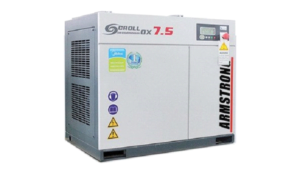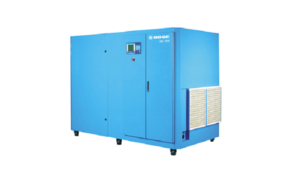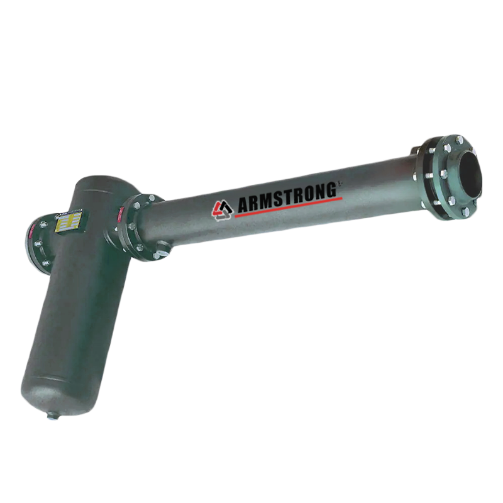Introduction
Air compressors have been around for many years because of their versatility and vitality in various industries. They provide compressed and pressurized air, which is essential for various operations at factories and workshops.
Looking back at the history of air compressor, its earliest version could be traced back to the human lung. It has the capacity to continuously process air throughout the human body. However, this vital organ is hardly adequate for metalworking tasks, which led to the demand for stronger and more mechanical air compressors.
This is when people came up with early models of air compressors. In 1500 B.C., bellows were invented as a handheld air compressor that produced a blast of air that is ideal for achieving higher temperature fires. As years went by, bellows were replaced with a waterwheel-driven blowing cylinder that is invented by John Smeaton.
Eventually, Smeaton’s invention was replaced by John Wilkinson’s blasting machine in 1776. It then became the archetype for later mechanical air compressors. However, it wasn’t only by 1800 that people used air compressors to transfer energy. After that, more innovations in air compressors became apparent in the market and soon began integrating electricity and pneumatic energy.
Today, there are various types of air compressors. They have even become smaller and less bulky, proving to be more useful even in other tasks such as inflating a tire or unclogging your sink at home.
What is an Air Compressor in the Philippines?
An air compressor is a pneumatic device that converts power into energy stored in pressurized air using an electric motor, diesel, or gasoline engine. It also forces more air into a storage tank, which later on increases the air pressure. Once the tank’s pressure reaches its limit, the air compressor automatically shuts off. The compressed air is then held in the tank until it’s used.
Keep in mind that air compressors are different from pumps. Air compressors work for any gas or air. Pumps, on the other hand, work on a liquid.
Air compressors are used in various applications—from home workshops to garage projects. They power air tools, phase shift refrigerants, and propel gas via their pipelines.
These machines can also vary in different sizes and designs, depending on the specific needs and preferences.
What are the main components of an air compressor?
The basic components of the air compressor resemble engines used in automobiles. However, take note that air compressor parts cannot be used for automobile engines.
The basic parts are the pump, electric motor, and receiver (tank).
Pump – This part compresses the air and discharges it to the receiver. There is a minimum of 2 pump cylinders for two-stage air compressors. These can produce pressures from 145 to 175 psi by compressing the air twice. The first instance is in a larger, low-pressure cylinder, then the second occurs in a smaller high-pressure cylinder).
Electric motor – This component powers the compressor pump. It drives a pulley with two belts that help in transferring power from motors to pump pistons via flywheel and crankshaft. The flywheel fan then helps the compressor pump cool down.
Receiver – This is the part that stores the compressed air. The check valve at the receiver’s inlet prevents the compressed air in the receiver from flowing back to the compressor pump. The receiver has vertical and horizontal variants, and either could be used depending on its size and capacity.
How do Air Compressors work?
Air compressors could run as a stand-alone installation or a complement for other tools. Proper usage of these machines could truly help with productivity and efficiency. It could also help avoid damages and accidents. However, keep in mind that their efficiency and performance may be affected by installation, maintenance, and handling.
So how does an air compressor really work?
Air compressors work by forcing air into a container and then pressurizing it. When air is finally forced through an opening in the tank, that’s where the pressure starts to build up. From there, the pressurized air can be used to power a variety of tools. These include air hammers, air drills, paint sprayers, cordless drills, impact wrenches, and sanders.
There are two methods to achieve air compression: positive and dynamic displacement. The involved process in each method varies, but their outcomes are similar.
Positive displacement air compressors work by forcing the air in a chamber where the volume is being decreased to compress the air. This method requires equipment for industrial workloads while others are better for hobbyists or private projects. The 3 main types of air compressors that use positive displacement are rotary screw, piston-type, and vane air compressors.
Dynamic displacement, on the other hand, includes centrifugal and axial compressors. This kind of displacement utilizes a rotating blade powered by an engine to generate airflow. Once the air is restricted to create pressure, the kinetic energy is stored within the compressor.
Dynamic displacement compressors are mainly designed for large projects such as chemical plants or steel manufacturers. This type can easily be found at local mechanic shops.
Types of Air Compressor in the Philippines
There are many types of air compressors on the market today, and the one you need can be determined by its capability and function.
If you’re concerned about the power source, you might need to consider gas and diesel-powered air compressors, as well as electric compressors. Meanwhile, if you’re interested in pressure output, there’s the low-pressure air compressor (LPAC), which has a maximum discharge pressure of 150 psi. There’s also the medium-pressure compressor, which has a discharge pressure ranging from 151 to 1,000 PSI, and the high-pressure air compressor, which has a discharge pressure greater than 1,000 PSI.
Air compressors can also be classified based on their air displacement. Positive displacement and dynamic displacement are the two types of air displacement.
Positive displacement occurs as air is forced into a chamber. After that, the volume of the air is reduced to allow compression to take place. The valves then open, allowing air from the compression chamber to reach the storage tank with force. Any positive displacement compressors perform better when designed for industrial workloads.
Dynamic displacement, on the other hand, uses spinning blades and impellers to drive air into chambers. The air is then confined to generate friction, and the kinetic energy is retained within the compressor. This kind of compressor is mostly intended for major projects, such as chemical or manufacturing plants.
Rotary Screw Compressor
Rotary screw compressors have two internal “screws” that rotate in opposite directions. When they spin, these components catch and compress air between them, causing continuous movement. This is type of air compressor is one of the easiest to maintain. Its engines are normally industrial-sized and ideal for continuous operation.


Another distinguishing feature of rotary screw compressors is that they are cooled by oil. The oil is pumped into the air stream, where it absorbs the heat of compression as it is produced. After that, the hot oil is cooled using either air or a water-cooled heat exchanger. Once the compressor has been cooled, the working components are never exposed to high operating temperatures.
The cooling oil is never cracked nor burnt. There are no hot spots within the air end regardless of the load on the compressor. This results in trouble-free service and high efficiency.
Some of the models available for this type are the ARMSTRONG Scroll Compressor and the BOGE Screw Compressor, which are both available at Compresstech.
Reciprocating Compressor
This type is also known as a piston compressor because it uses pistons operated by a crankshaft to deliver high-pressure gas. It is often found at smaller construction sites and is not intended for continuous usage. In many cases, the tank and compressor are installed in a single frame or skid as a “packaged unit.”
Reciprocating compressors are mostly used to supply compressed air as a source of energy, but they are also employed by pipeline operators for natural gas transportation. It comes in both oil-lubricated and oil-free versions. Other designs are better suited for some applications that require oil-free air of the highest quality.
There are two kinds of reciprocating compressors: single-stage and two-stage.
Single-Stage Compressor

A single-stage compressor, like the Ingersoll Rand SSCI Series, is less expensive than other types of compressors. It is also often easier to obtain because it can be found in almost any mechanic shop.
The air is compressed on one side of the piston in this compressor, while the other side handles its operation where the air is pulled in as the piston goes downward. The air is eventually compressed as it goes upward.
Two-Stage Compressor
This is also referred to as dual-stage compressor. In a two-stage compressor, two compression chambers are located on either side of a piston. This compressor is often water-cooled by a continuous stream of water flowing through the engine, providing a superior cooling system than other compressors.

Two-stage compressors are more expensive than single-stage compressors. This is why it is better suited for factories and workshops than individual projects. A great example of this type of compressor is the Armstrong 2 Stage Series.
Uses of Air Compressors in the Philippines
Air compressors are used in a variety of industries. They are also prevalent in situations that are known to most customers. Some of the common sectors that use air compressors include construction, electronics, machinery or manufacturing, chemical, food, metal, steel, and textile.
Construction
Air compressors are used in the construction industry for a variety of pneumatic tools and equipment. Power from air compressors is helpful for those in distant locations where there is no consistent supply of electricity, gasoline, or fuel, as these devices offer continuous power.
Aside from that, air compressors may power other portable equipment due to their mobile power source, which does not overheat or spike abruptly. They also power dozens of these equipment in a variety of industries, including infrastructure development, road construction, demolition, and commercial and residential projects.
Machinery or Manufacturing
The manufacturing industry has been dependent on the multifaceted character of air compressors. These machines improve manufacturing productivity, from plastics and metal fabrication to food and pharmaceutical packaging.
Air compressors are used in the manufacturing business to guarantee that food, beverage, and pharmaceutical items are clean, contaminant-free, and tightly sealed. They can also power conveyor belts, sprayers, presses, and packing devices simultaneously.
Electronics
Air compressors provide power in a wide range of electrical and electronic equipment. Potential energy is stored in the compressor tanks and then released in a regulated manner utilizing kinetic energy. This provided power is necessary to operate pneumatic equipment or to perform cleaning activities.
Some electrical tools that use compressed air are nail guns, air staplers, air sanders, spray guns, and sandblasters.
Chemical
Air compressors have been used in chemical facilities and systems to monitor, manage, and regulate tasks since, unlike electricity, they produce no spark.
Toxic and combustible gases are used in the production of chemicals and petrochemicals. As a result, air compressors are critical for both safety and efficiency. They ensure that working conditions are strictly regulated and that employees are adequately protected from hazardous substances.
Food
Air compressors are used by food and beverage manufacturers to power their continuous activities. Because electricity from air compressors is generated on-site, end-users have considerably more control over their usage and air quality.
The usual operations under this industry include:
⦁ Packing and Palletizing Food Items
⦁ Closing and Inspecting Devices
⦁ Filling Equipment for Beverages
Metal and Steel
Because it keeps the production moving swiftly and effectively, an air compressor serves as the primary power source for metal and steel manufacturing. It powers machines used for cutting, welding, riveting, sandblasting, and completing metal and steel projects.
After all, metal and steel fabrication use a lot of compressed air, whether it’s for clamping or unclamping spindles, running pneumatic equipment, or turning on shear and puncher machines.
Textile
The textile industry has relied on air compressors to increase production, avoid contamination from air and fluid mixtures, and decrease waste.
Air compressors are commonly used in this sector to power air-jet looms, spinning machines, ginning mills, or sock knitting machines. In addition, they drain and dry colored carpets, secure fabric on cutting tables, and clean knitting machines.
How to Maintain your Air Compressor?
⦁ Read and follow the manual – The manual contains recommendations to help you operate the air compressor for a longer period of time.
⦁ Drain moisture from tanks – Most tanks feature a valve for draining the moisture that collects in the compressor, which is especially important if you live in a humid environment.
⦁ Clean intake vents – This will keep the quality of your air compressor from deteriorating.
⦁ Tighten all fasteners – An air compressor can unexpectedly have loose screws, nuts, and bolts. To avoid disasters, be sure to inspect every component.
⦁ Check hoses regularly – Hoses can break or corrode, causing leaks and strain on other components. Check them regularly and replace them if they get damaged.
⦁ Test the safety shutdown system – Check your air compressor to see whether it has a safety shutdown system. If the compressor becomes too hot or the engine’s oil pressure becomes too low, this feature immediately shuts it off.
⦁ Check and change air filters and separator element – The dirt in the air filter and separator element builds up over time. Check these components from time to time and replace them every 1,000 hours of operation.
⦁ Clean fuel tank and heat exchangers – As with any engine, you have to periodically clean the components of your air compressor to ensure optimal operating conditions. Remove any residual build-up from the fuel and heat exchangers to increase the life span of your compressor.
⦁ Check and change compressor oil – If you have an oil-injected air compressor, you should change the oil every 500 to 1,000 hours to maintain efficient functioning.
Where Can You Buy Air Compressors in the Philippines?
Compresstech Resources Inc. offers energy-efficient and reliable air compressors for every purpose. Our air compressors are built to last and are intended to meet industrial requirements without sacrificing durability or energy efficiency.
We offer rotary screw and reciprocating compressors, vacuum equipment, air treatment solutions, and industrial gas products, such as nitrogen and oxygen generators.
Conclusion
Many industries depend on the usefulness, functionalities, and versatility of air compressors. At Compresstech, we understand the importance of quality air compressors for your operations. Whether you need oil-free or oil-injected, electric or gas, portable or high-pressure compressors, you can rely on us!
Please visit our website now to learn more about our goods and services.

